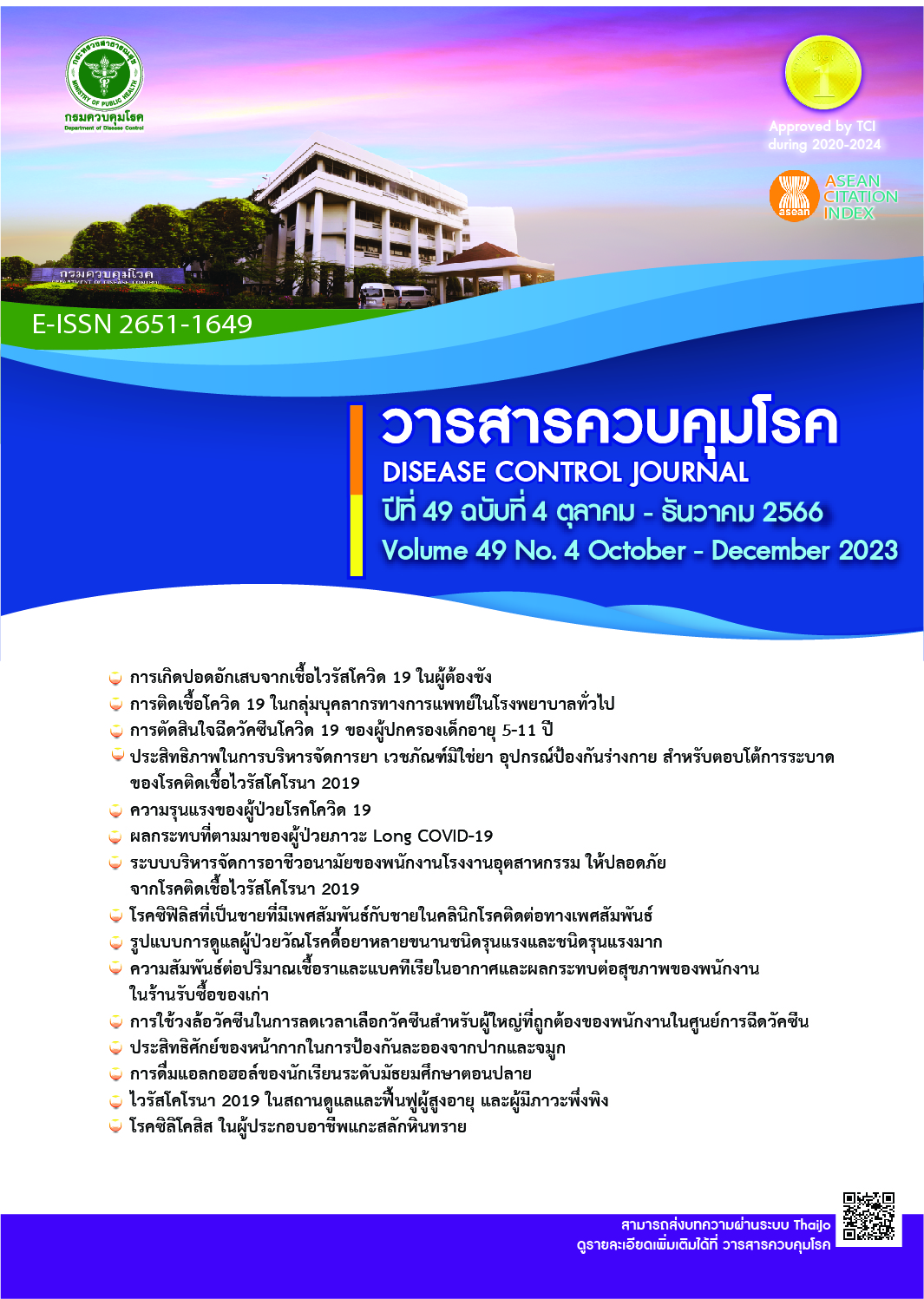A study of the consequences of long COVID patients in Buriram Province
DOI:
https://doi.org/10.14456/dcj.2023.61Keywords:
long COVID, symptoms, impacts, Buriram ProvinceAbstract
The purposes of this research were to study the lifestyles of long COVID patients before and after infection with COVID-19, to identify symptoms or complications after infection with COVID-19, to measure the level of impacts of symptoms or complications after infection with COVID-19, and to compare the proportion of occurrence of symptoms or complications after infection with COVID-19 based on basic data of Long COVID patients in Buriram Province. Research participants, were 400 people who had been infected with COVID-19, obtained through the snowball sampling method. The research tool was a questionnaire. Statistics used for data analysis included frequency, percentage, and chi-square test. Research findings showed that the most respondents lifestyles before and after infection with COVID-19 were not different. The first most common symptoms or complications suffered after the infection were fatigue, chronic cough, insomnia, dizziness, muscle weakness with body and joint pain, respectively. The level of impacts that those symptoms had on the body or lifestyle was relatively low. When comparing the proportion of occurrence of the symptoms or complications after infection with COVID-19, it was found that differences in personal factors resulted in significantly different levels of impacts of symptoms both in terms of physical health and living (p<0.05).
Downloads
References
Ministry of Public Health (TH). Progress report on the COVID-19 situation [Internet]. World Health Organizaton Thailand; 2022 [cited 2022 Aug 16]. 24 p. Available from: https://cdn.who.int/media/docs/default-source/searo/thailand/2022_06_08_tha-sitrep-239-covid-19_th.pdf?sfvrsn=2d393008_1 (in Thai)
Huang C, Wang Y, Li X, Ren L, Zhao J, Hu Y, et al. Clinical features of patients infected with 2019 novel coronavirus in Wuhan, China. Lancet [Internet]. 2020 [cited 2022 Aug 16]; 395(10223):497-506. Available from: https: //doi.org/10.1016/S0140-6736(20) 30183-5
Li X, Ma X. Acute respiratory failure in COVID-19: is it "typical" ARDS?. Crit care [Internet]. 2020 [cited 2022 Aug 20];24(1) :198. Available from: https://ccforum.biomedcentral.com/articles/ 10.1186/s13054-020-02911-9
Chierakul N. Suspected pneumonia COVID for the people. Moh Chao Ban. 2021;43(509):16-22. (in Thai)
Huang C, Huang L, Wang Y, Li X, Ren L, Gu X, et al. 6-month consequences of COVID-19 in patients discharged from hospital: a cohort study. Lancet [Internet]. 2021 [cited 2022 Aug 20];397(10270):220-32. Available from: https://doi.org/10.1016/S0140-6736(20)32656-8
Tantipasawasin P, Tantipasawasin S. Post-COVID condition (Long COVID). Chonburi Hospital Journal [Internet]. 2022 [cited 2022 Jun 29];47(1):67-84 p. Available from: https://thaidj.org/index.php/CHJ/article/view/11958 (in Thai)
Raveendran AV, Jayadevan R, Sashidharan S. Long COVID: An overview. Diabetes Metab Syndr [Internet]. 2021 [cited 2022 Oct 3];15(3):869-75. Available from: https://doi.org/10.1016/j.dsx.2021.04.007
Greenhalgh T, Knight M, A'Court C, Buxton M, Husain L. Management of post-acute COVID-19 in primary care. BMJ [Internet]. 2020 [cited 2022 Oct 3];370, m3026. Available from: https://doi.org/10.1136/bmj.m3026
Centers for Disease Control and Prevention. Long COVID or post-COVID conditions [Internet]. CDC; 2022 [cited 2022 Oct 3]. Available from: https://www.cdc.gov/coronavirus/2019-ncov/long-term-effects/index.html
Yong SJ. Long COVID or post-COVID-19 syndrome: putative pathophysiology, risk factors, and treatments. Infect Dis (Lond). 2022; 53(10):737-54.
Institute of Medical Research and Technology Assessment (TH). Long-Term impact on health of people who have been sick of COVID-19 and guidelines for health service provision. Journal of The Department of Medical Services [Internet]. 2022 [cited 2022 Dec 5];47(2):5-8 p. Available from: https://he02.tci-thaijo.org/index.php/JDMS/article/view/258247 (in Thai)
Cochran WG. Sampling techniques. 3rd ed. New York: John Wiley & Sons; 1977.
Srisa-ard B. Interpretation when using the estimation scale data collection tool. JEM-MSU. 1996;1(2):64-70. (in Thai)
Devellis RF. Scale development: theory and applications. 3rd ed. New York: Sage Publications; 2012.
Chantasorn U. Nonparametrics. Bangkok: Physics Center Publisher; 1998. (in Thai)
Ziauddeen N, Gurdasani D, O’Hara ME, Hastie C, Roderick P, Yao G, et al. Characteristics and impact of Long Covid: Findings from an online survey. PLoS One [Internet]. 2022 [cited 2022 Dec 5];17(3):e0264331. Available from: https://doi.org/10.1371/journal.pone. 0264331
Wangchalabovorn M, Weerametachai S, Leesri T. Prevalence of Post COVID-19 Conditions in SARS-CoV-2 Infected Patients at 3-month telephone follow-up. Regional Health Promotion Center 9 Journal [Internet]. 2022. [cited 2022 Dec 7];16(1):265-84 p. Available from: https://he02.tci-thaijo.org/index.php/RHPC9Journal/article/view/255986 (in Thai)
Channarong M. Factors Relating to Post Discharge Persistence of Symptoms After Hospitalization Among Persons with Coronavirus Disease 2019. Journal of Health and Nursing Education [Internet]. 2022. [cited 2022 Dec 7];28(1):1-6 p. Available from: https://he02.tci-thaijo.org/index.php/Jolbcnm/article/view/257651 /176186 (in Thai)
Downloads
Published
How to Cite
Issue
Section
License
Copyright (c) 2023 Disease Control Journal

This work is licensed under a Creative Commons Attribution-NonCommercial-NoDerivatives 4.0 International License.
Articles published in the Disease Control Journal are considered as academic work, research or analysis of the personal opinion of the authors, not the opinion of the Thailand Department of Disease Control or editorial team. The authors must be responsible for their articles.






